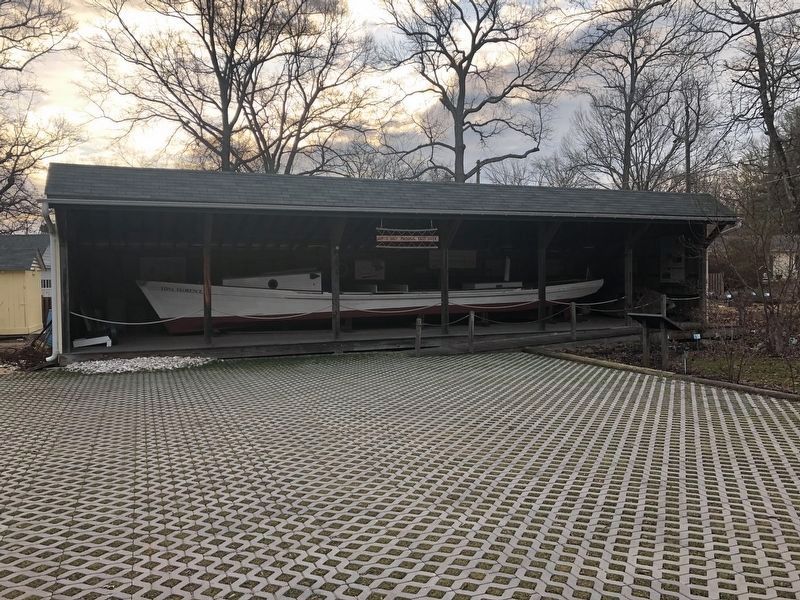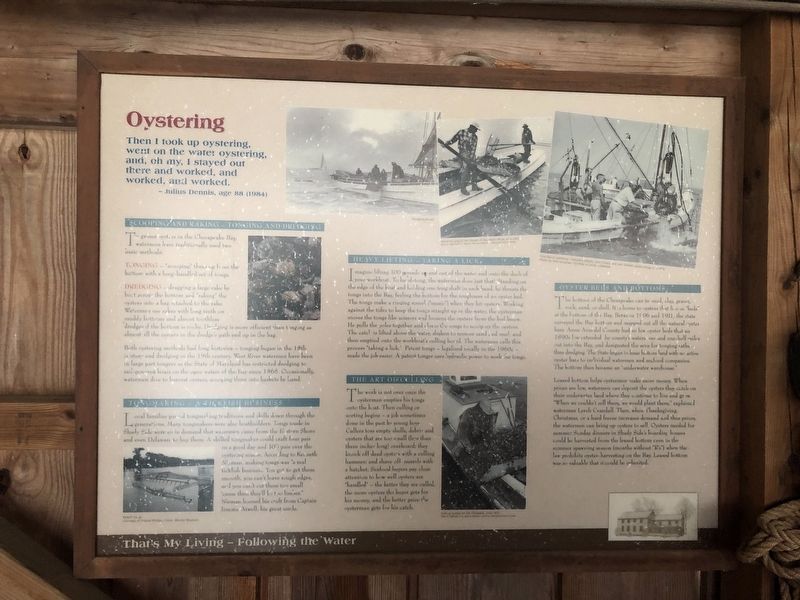Shady Side in Anne Arundel County, Maryland — The American Northeast (Mid-Atlantic)
Oystering
— Julius Dennis, age 88 (1984)
Scooping and Raking — Tonging and Dredging
To gather oysters in the Chesapeake Bay, watermen have traditionally used to basic methods:
Tonging — "scooping" them up from the bottom with a long-handled set of tongs.
Dredging — dragging a large rake by boat across the bottom and "raking" the oysters into a bag attached to the rake. Watermen use rakes with long teeth on muddy bottoms and almost toothless dredges if the bottom is rocky. Dredging is more efficient than tonging as almost all the oysters in the dredge's path end up in the bag.
Both oystering methods had long histories — tonging began in the 18th century and dredging in the 19th century. West River watermen have been in large part tongers as the State of Maryland has restricted dredging to sail-powered boats on the open waters of the Bay since 1865. Occasionally, watermen dive to harvest oysters, scooping them into baskets by hand.
Tongmaking — A Ticklish Business
Local families passed tongmaking traditions and skills down through the generations. Many tongmakers were also boatbuilders. Tongs made in Shady Side were so in demand that watermen came from the Eastern Shore and even Delaware to buy them. A skilled tongmaker could craft four pair in a good day and 100 pair over the oystering season. According to Kenneth Neiman, making tongs was "a real ticklish business. You got to get them smooth, you can't leave rough edges, and you can't cut them too small 'cause then they'll be too limber." Nieman learned his craft from Captain Jimmie Atwell, his great uncle.
Heavy Lifting — Taking a Lick
Imagine lifting 100 pounds up and out of the water and onto the deck of your workboat. To hand-tong, the waterman does just that! Standing on the edge of the boat and holding one tong shaft in each hand, he thrusts the tongs into the Bay, feeling the bottom for the roughness of an oyster bed. The tongs make a ringing sound ("music") when they hit oysters. Working against the tides to keep the tongs straight up in the water, the oysterman moves the tongs like scissors and loosens the oysters from the bed below. He pulls the poles together and closes the tongs to scoop up the oysters. The catch is lifted above the water, shaken to remove sand and mud, and then emptied onto the workboat's culling board. The waterman calls this process "taking a lick." Patent tongs — legalized locally in the 1960s — made the job

Photographed By Devry Becker Jones (CC0), February 16, 2019
2. The marker is part of this outdoor exhibit.
The Art of Culling
The work is not over once the oysterman empties his tongs onto the boat. Then culling or sorting begins — a job sometimes done in the past by young boys. Cullers toss empty shells, debris and oysters that are too small (less than three inches long) overboard; they knock off dead oysters with a culling hammer; and shave off mussels with a hatchet. Seafood buyers pay close attention to how well oysters are "handled" — the better they are culled, the more oysters the buyer gets for his money, and the better price the oysterman gets for his catch.
Oyster Beds and Bottoms
The bottom of the Chesapeake can be mud, clay, gravel, rock, sand, or shell. It is home to oysters that live in "beds" at the bottom of the Bay. Between 1906 and 1911, the state surveyed the Bay bottom and mapped out all the natural oyster bars. Anne Arundel County had so few oyster beds that an 1890s low extended the county's waters one and one-half miles out into the Bay, and designated the area for tonging rather than dredging. The State began to lease bottom land with no active oyster bars to individual watermen and seafood companies. The bottom then became and "underwater warehouse."
Leased bottom helps oystermen make more money. When prices are low, watermen can deposit the oysters they catch on their underwater land where they continue to live and grow. "When we couldn't sell them, we would plant them," explained waterman Lerch Crandall. Then when Thanksgiving, Christmas, or a hard freeze increases demand and thus prices, the watermen can bring up oysters to sell. Oysters needed for summer Sunday dinners in Shady Side's boarding houses could be harvested from the leased bottom even in the summer spawning season (months without "R's") when the law prohibits oyster-harvesting on the Bay. Leased bottom was so valuable that it could be inherited.
That's My Living — Following the Water
Erected by Chesapeake Bay Gateways Network.
Topics. This historical marker is listed in these topic lists: Animals • Industry & Commerce • Waterways & Vessels. A significant historical year for this entry is 1865.
Location. 38° 50.958′ N, 76° 30.706′ W. Marker is in Shady Side, Maryland, in Anne Arundel County. Marker is on East West Shady Side Road west of Bast Avenue, on the right when traveling north. Touch for map. Marker is at or near this postal address: 1418 East West Shady Side Road, Shady Side MD 20764, United States of America. Touch for directions.
Other nearby markers. At least 8 other markers are within walking distance of this marker. Seasons of the Waterman (here, next to this marker); Fishing (a few steps from this marker); Crabbing (a few steps from this marker); Eels, Ducks, and Clams (a few steps from this marker); The Edna Florence (a few steps from this marker); Transformation of the Avery House and over a Century of Expansion (a few steps from this marker); Going to Market (a few steps from this marker); Edna Florence (a few steps from this marker). Touch for a list and map of all markers in Shady Side.
Credits. This page was last revised on March 18, 2019. It was originally submitted on February 16, 2019, by Devry Becker Jones of Washington, District of Columbia. This page has been viewed 182 times since then and 16 times this year. Photos: 1, 2. submitted on February 16, 2019, by Devry Becker Jones of Washington, District of Columbia. • Bill Pfingsten was the editor who published this page.
